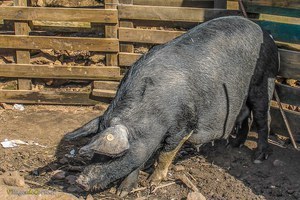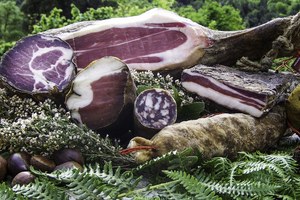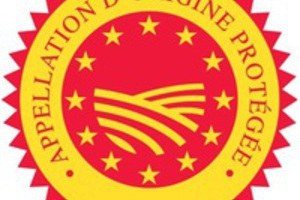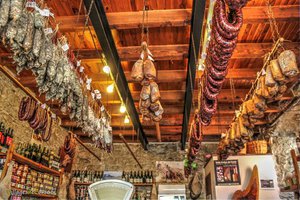- Activities
- Gastronomy
- Corsican charcuterie
- Salt and pepper, natural preservatives
The natural preservation of traditional Corsican charcuterie
Nitrites classified as carcinogenic since 2015
The classification of nitrites as a carcinogen has raised many questions. This preservative has been used for years in the agri-food industry, and regularly puts charcuterie on the front pages of newspapers.
Nitrates, nitrites, a little chemistry
Nitrates are molecules naturally present in soils, known by the chemical formula HNO3. They are transformed into nitrites when they come into contact with bacteria present in our bodies, such as in meat.
There are several types of nitrite, but the ones most commonly used in meat are ammonium nitrate (E252), sodium nitrate (E250) and potassium nitrate (E249). Ammonium nitrate (naturally occurring and known as saltpetre) is said to have been used as a preservative for 5,000 years.
Nitrate in water
Nitrates are always mentioned on the label of mineral water, and their harmfulness is well known, as they are the only element whose quantity is inversely proportional to water quality. Its presence in springs reveals the soil pollution caused by past wars, and today by agriculture, which uses nitrate as a fertilizer.
Why do manufacturers use nitrites in charcuterie?
We often hear that nitrites are used to give ham the pink color that consumers demand. Less well known is the fact that nitrites speed up production times. Another more solid argument put forward by manufacturers is that nitrites prevent the development of bacteria responsible for infections such as salmonellosis, or botulism, a serious paralytic disease. This is true, but it's wrong to suggest that it's the only solution. To untangle the truth from the false, see the article on the risks of nitrites in charcuterie on the PourquoiDocteur website, which quotes Axel Kahn, geneticist and President of the Ligue contre le cancer from 2019 to 2021:
"If we want to save French charcuterie, we have to make it less carcinogenic by getting rid of nitrites. This is entirely possible, as they serve no purpose during the curing process, and other means exist to limit the germination of botulinum spores."
Axel Kahn, president of the Ligue contre le cancer between 2019 and. 2021
This argument is also beaten to the punch by journalist Guillaume Coudray in an online article for l'info durable entitled Tout ce qu'il faut savoir sur les nitrites dans le jambon.
Artisanal Corsican charcuterie uses salt and pepper, not nitrite
Back to our pigs, on the use or otherwise of nitrites in Corsican charcuterie. The majority of traditional charcuterie producers don't use nitrites, and they'll tell you so, because traditional preservation involves salt and pepper.
There are, however, some charcuterie products that are mainly industrial, with labels mentioning nitrites E250, E249, E252 or saltpetre in their composition. If in doubt, ask the producer.
Preservation, the origin of Corsican charcuterie
It's important to remember that the cured meats that make up Corsican charcuterie - coppa, lonzu, prisuttu (Corsican ham) or saucisson - were not originally invented for their gastronomic value. Traditional charcuterie, whether from Corsica or elsewhere, enabled meat to be preserved for a long time, when freezers didn't exist.
The power of salt
This brings us to the very principle of charcuterie: long preservation. Traditional Corsican charcuterie is preserved by two table-top ingredients: salt and pepper.
In fact, each Corsican charcuterie recipe has one thing in common. The pieces of meat are immersed in coarse salt for several days to several weeks. The salt thus impregnates the meat, and is the key element in its preservation. The cured meats are then smoked and dried, and matured for up to 36 months in the case of Corsican ham.
Salt is an excellent preservative because, in the right proportions, it stops microbial growth in the water. It is also used in the brining of olives and gherkins.
To summarize
Traditional Corsican charcuterie is by definition preserved by salt and pepper. It's during the maturing process that it acquires its flavor, as the months go by, in contrast to industrial needs, where the speed and quantity of production now depend heavily on nitrites. However, even without nitrite, charcuterie should be eaten in moderation, as part of a healthy diet in which excess is always forbidden.
The history of nitrates, from weapon of war to agricultural fertilizer
A sad illustration of the dual function of nitrates could be summed up by the explosion in the port of Beirut in 2020, caused by a warehouse stockpiling ammonium nitrate destined for worldwide export as a crop fertilizer.
Before being used to promote plant growth, ammonium nitrate was used as an explosive more than a century ago. After the end of 14-18, the survivors found that the fields had never been as green as they were after the 1st World War, and for good reason: they had been bombarded with ammonium nitrate-based explosives. Plants need nitrogen for their growth, a chemical element present mainly in the air, which they draw from the soil, particularly after rain. A chemical element also present in nitrates, which easily reach the roots and are well assimilated by plants.
This observation gave rise to the idea of agricultural use of this molecule, which would be implemented after the Second World War.
The cascading effect of nitrates, from unreasonable agriculture
The use of nitrates dealt a blow to ancestral cereal seeds, which suffered from lodging, a phenomenon that lays down plants due to excess nitrogen, as after heavy rain. Departing from natural common sense, researchers decided to crossbreed varieties to dwarf them, reducing their size in order to withstand excess nitrogen, reducing agriculture to so-called modern varieties. From then on, yields soared, and the agricultural revolution was underway, but at what price?
The obsession with nitrates triggered a chain reaction, described by Bernard Ronot - a former farmer committed to safeguarding ancestral seeds - in this video interview, summarized in a few points:
- 1) Selection of dwarf varieties and abandonment of tall ancestral seeds, to avoid lodging of cereals, due to the excess nitrogen provided by nitrates.
- 2) As a result of 1), vulpine, a grassy plant that competes with wheat, was taller than modern dwarfed wheat seeds, and overshadowed them.
- 3) In response to competition from vulpine, the industrial use of isoproturon, a herbicide, to destroy vulpine without affecting wheat, resulting in an explosion in yield.
- 4) With artificial nitrogen feeding and elimination of competition, wheat becomes lazy and its roots no longer go down as deep, depriving itself of essential trace elements (iron, potassium, etc.), causing an imbalance in the plant, and encouraging the appearance of fungi on the plant.
- 5) Use of fungicides to eliminate fungi
- 6) Excess nitrogen, which favors the rise of sap and thus the arrival of aphids in abundance.
- 7) Use of insecticides to eliminate aphids



